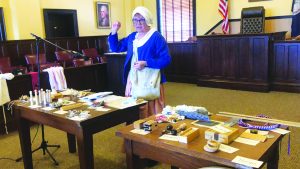Wearing a full pink skirt, ruffled white shirt, blue striped bodice, blue jacket and white bonnet, Gail Vogler showed attendees of the February Afternoon Lecture how children played during Colonial Days.

That was the time period from when European settlers came to North America, at the start of the 17th century, until the colonies became incorporated into the United States almost 200 years later. Children did not get many toys during those days, she said, and those they had were intended to teach as well as to pass time.
Toys were made with available materials such as cloth, wood, clay and string. Some, still popular today, included Bilboquet (tossing a ball into a cup), jacks, marbles (of clay), dominoes, cat’s cradle and dice.
Dolls were made with corn husks or scraps of cloth. A “church doll” was fashioned simply from a handkerchief and served to entertain children while in church; it would not make any distraction-causing noise when dropped or bumped about.
Some games then have been largely forgotten – Hoops, in which children guided along a tall hoop from behind with a stick; peg top, which spins when it hits the ground; and buzz saw, in which twisted strings cause an attached disc to move and buzz.
Vogler called up Anne Moore to help demonstrate Graces, in which two players use sticks to toss a ribbon-wrapped hoop back and forth.
A video of her program can be seen on the Historical Society’s YouTube page @martinsvillehenrycountyhs and its website, www.mhchistoricalsociety.org.



